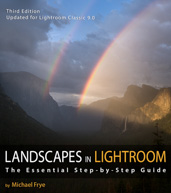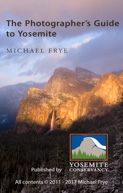In the Moment:
Michael Frye's Landscape Photography Blog
by Michael Frye | Feb 21, 2012 | Yosemite Photo Conditions
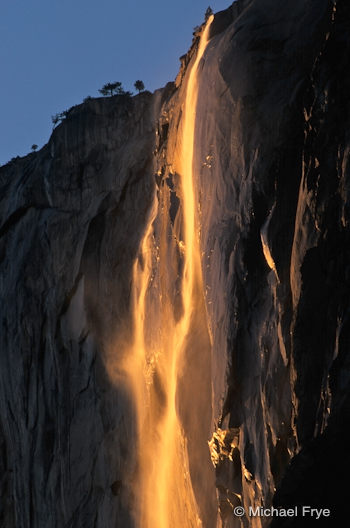
Horsetail Fall at sunset, February 1995
What makes Horsetail Fall so special? It seemed appropriate at this time of year to re-post this article from my 25 Years in Yosemite blog, where I talk about the photographic history of this waterfall, and the unique topography that creates the lighting phenomenon so many photographers have tried to capture:
Many people remember Yosemite’s firefall. On summer evenings from 1872 until 1968 the owners and employees of the Glacier Point Hotel pushed burning hot embers off the top of the Glacier Point cliff toward Yosemite Valley. The effect resembled a waterfall of fire. When the hotel burned down in 1969 the park service decided to end the ritual because this unnatural event caused visitors to trample meadows in their attempts to find a viewing spot.
I first visited Yosemite in 1980, so I never saw the firefall. On the park’s centennial anniversary in 1990 rumors spread that the park service would reenact the firefall, unannounced, but it never happened.
Yosemite, though, has an amazing natural “firefall.” For about ten days each February, if conditions are right, a thin ribbon of water dropping from the East Buttress of El Capitan, called Horsetail Fall, turns vivid orange when backlit by the setting sun.
(more…)
by Michael Frye | Feb 19, 2012 | Yosemite Photo Conditions
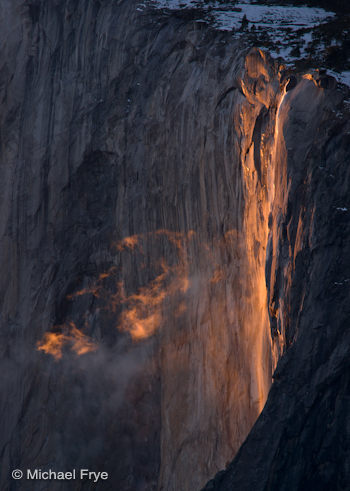
Horsetail Fall, 5:27 p.m., Wednesday, February 15th
First, a reminder that this is the last day to get a discount on my new eBook, Exposure for Outdoor Photography. Until midnight tonight you can use the code EXPOSURE4 at checkout to get the book for only 4 dollars. Or use the code EXPOSURE20 to get 20 percent off if you buy five or more Craft & Vision eBooks—including my previous volume, Light & Land: Landscapes in the Digital Darkroom.
Now, on to Horsetail Fall. Yosemite Valley received about four inches of snow on Tuesday night, and higher elevations got a little bit more. Unfortunately that precipitation did little to improve the water volume in Horsetail Fall. It’s flowing, but barely. Yet it’s amazing how little water it actually takes. You can strain your eyes to detect any flow at all for most of the day, and then as the sun lowers it highlights the fall perfectly and makes whatever water there is stand out.
The accompanying photographs were made on Wednesday and Thursday evenings while I was teaching private workshops, and show the current conditions pretty well. On Wednesday some mist drifted past the fall, adding interest, but distant clouds dimmed the light before it reached its most intense color. On Thursday, the light was about as good as it gets for Horsetail, lasting right until the theoretical sunset time, with the cliff behind the fall shaded. If only there was more water!
(more…)
by Michael Frye | Feb 12, 2012 | Yosemite Photo Conditions
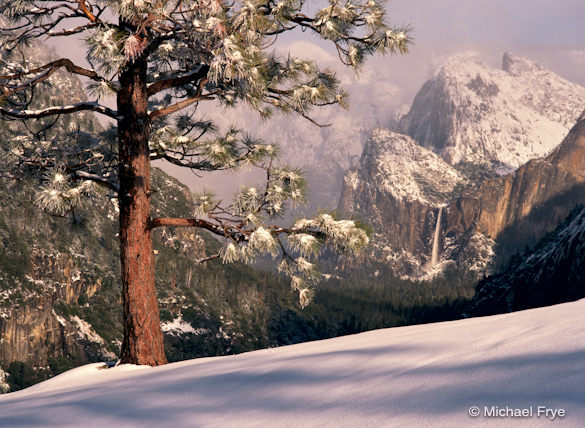
February light on Bridalveil Fall from near Turtleback Dome
First, I’m going to have a big announcement later this week—stay tuned!
Next, I’ve been getting lots of questions about Horsetail Fall. Since my last post about this not much has changed; there is little water in Horsetail right now. There’s snow in the forecast for tonight and tomorrow, so that should help, but they’re only predicting 6-8 inches, and I don’t know whether that will be enough to make a significant difference. If the weather warms immediately afterward and melts some of that new snow the water volume could get a bump, but it’s likely to be short-lived.
But there are other things to photograph in Yosemite in February. That storm is predicted to be a cold one, which means fresh snow in Yosemite Valley. And when the storm ends we could see some nice clearing storm conditions.
(more…)
by Michael Frye | Dec 15, 2011 | Announcements, Workshops
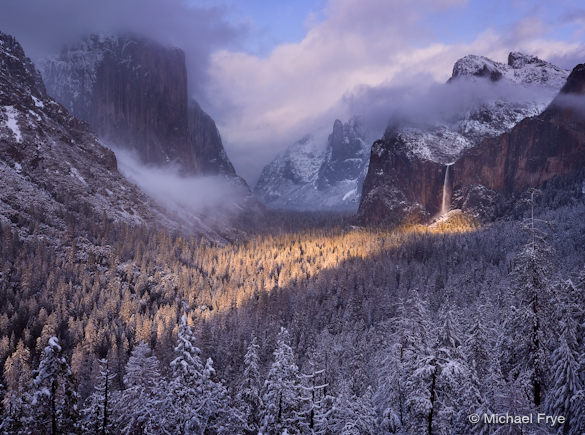
Spotlight on Bridalveil Fall
Just a quick note to let you know that, due to a cancellation, there’s one space available in my Landscapes in the Digital Darkroom: Mastering Lightroom workshop, January 16-20, 2012. And since it’s in January, it should be no problem to get a hotel room this late—and at off-season rates! Click here to register and grab that last space.
Meanwhile, my Spring Digital Camera workshop is full, and the Eastern Sierra Fall Color workshop filled within a few days. But there’s still space left in the Hidden Yosemite (July), Full Moon Night Photography (July-August), and Digital Landscape (October) workshops.
—Michael Frye
Related Posts: 2012 Workshops Announced; Two New Workshops for 2012
Michael Frye is a professional photographer specializing in landscapes and nature. He is the author and photographer of The Photographer’s Guide to Yosemite, Yosemite Meditations, and Digital Landscape Photography: In the Footsteps of Ansel Adams and the Great Masters, plus the eBook Light & Land: Landscapes in the Digital Darkroom. He has written numerous magazine articles on the art and technique of photography, and his images have been published in over thirty countries around the world. Michael has lived either in or near Yosemite National Park since 1983, currently residing just outside the park in Mariposa, California.
by Michael Frye | Dec 14, 2011 | Advanced Techniques
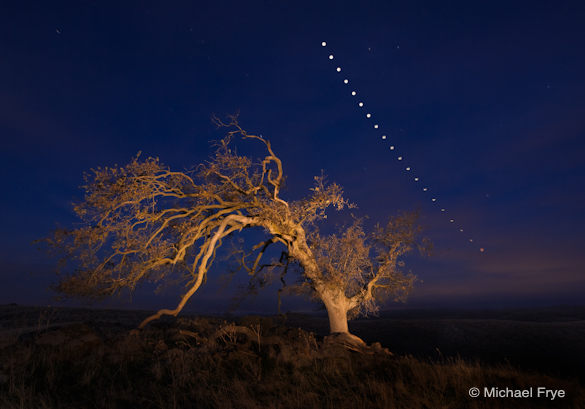
Oak tree and lunar eclipse sequence, December 10th, 2011
For me the hardest part about photographing last Saturday morning’s lunar eclipse was finding a good location. The fully-eclipsed moon would be close to the horizon in the west-northwest, so I needed a clear view in that direction, ideally with an interesting object in the foreground.
No place in Yosemite seemed to fit—too many mountains in the way. But I thought a remote region of western Mariposa County, with rolling hills and scattered oaks, might work. A week before the eclipse I scouted this area and found a photogenic oak tree on top of hill that seemed to line up with the projected path of the eclipse.
Friday night my student Erik and I got a couple hours of sleep, drove out to this spot, hiked up the hill, set up our cameras, and started our interval timers to capture a sequence of moon images ten minutes apart. We had a long wait, but it wasn’t too cold, and we enjoyed our peaceful, moonlit surroundings. A pair of great-horned owls serenaded us, and groups of coyotes howled at regular intervals. At one point Erik watched four coyotes climb a nearby moonlit hill, then saw one of them stop and howl.
(more…)












